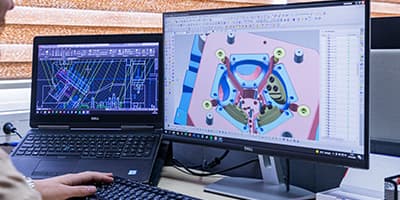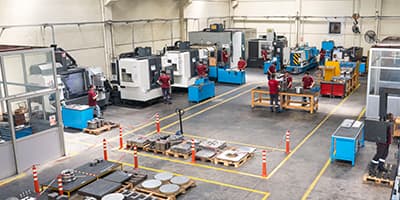- +90 236 233 20 03
- info@metamold.com
- Customer Portal

At Metamold, we offer the most innovative and reliable solutions in the aluminum molds sector. With our high-tech production processes, expert team, and customer-focused approach, we provide design and manufacturing services tailored to each project. Our aluminum molds offer superior durability, precision, and efficiency, and are used in a wide range of industries from automotive to aerospace. We are here to contribute to your success with quality, trust, and sustainable solutions.
Aluminum molds are specialized molds used for shaping aluminum metal through casting, injection, or other processing methods. Aluminum, being a lightweight, durable, and workable material, has a wide range of applications in many industries such as automotive, construction, aerospace, and electronics.
High Pressure Die Casting (HPDC):
It is a method where aluminum is injected into a mold at high pressure to produce thin-walled, complex parts. It provides rapid production and high surface quality. Used in the automotive and electronics industries.
Low Pressure Die Casting (LPDC):
This method produces more durable and thicker parts by filling the mold with aluminum at low pressure. It yields homogeneous and pore-free structures. Preferred in the automotive and aerospace industries.
Sand Casting Mold:
A traditional method where aluminum is shaped in sand molds. Large and complex parts can be produced at a low cost. Suitable for automotive and industrial machine parts.
Die Casting Mold:
This method uses metal molds to allow liquid aluminum to flow into the mold under the influence of gravity. It offers high quality, smooth surfaces, and long lifespan. Used in the automotive and white goods industries.

Mold Design
The 3D model of the part to be produced is created using CAD software. Simulations test the casting process, and prototype production may be required.

Production Stages
Raw materials are prepared, precision machining is performed on CNC machines. Heat treatment is applied to increase mold strength, and finally, grinding and polishing enhance surface quality.
| Mold Type | Mold Size | Complexity | Material | Approximate Price Range |
|---|---|---|---|---|
| High Pressure Die Casting (HPDC) | Small (10x10 cm) | Low | 6061 Aluminum | 5,000 - 10,000 USD |
| High Pressure Die Casting (HPDC) | Medium (30x30 cm) | Medium | 7075 Aluminum | 10,000 - 25,000 USD |
| Low Pressure Die Casting (LPDC) | Medium (30x30 cm) | High | 6061 Aluminum + Steel | 15,000 - 30,000 USD |
| Sand Casting Mold | Large (50x50 cm) | Medium | 6061 Aluminum | 3,000 - 8,000 USD |
| Permanent Mold Casting | Medium (30x30 cm) | High | 6061 Aluminum + Copper | 7,000 - 15,000 USD |
| Prototype Mold | Small (10x10 cm) | Low | 3D Printing Material | 1,000 - 3,000 USD |
Factors Affecting Prices:
Durability and Longevity: Aluminum molds are resistant to wear and deformation, providing long-lasting and corrosion-resistant performance. These features ensure high performance even in challenging production environments.
High Heat Resistance: Aluminum, with its excellent thermal conductivity, allows for rapid cooling and is resistant to high temperatures. This increases production speed and helps achieve uniform parts.
High Precision and Quality: Aluminum molds provide high surface quality and precision, even with complex geometries. They ensure repeatability and low error rates in mass production, enhancing quality.

Maintenance Process
Repair Requirements and Techniques
What is an aluminum mold?
An aluminum mold is a specialized mold used in various production processes involving aluminum or aluminum alloys. These molds allow for the shaping of aluminum through casting, injection, and other methods. They are commonly used in the automotive, aerospace, electronics, and white goods industries.
What methods are used to produce aluminum molds?
Aluminum molds are typically produced using CNC machining, casting, and mold design. These processes require high precision and technology. Molds are produced using high pressure die casting (HPDC), low pressure die casting (LPDC), sand casting, and die casting methods.
What are the advantages of aluminum molds?
Aluminum molds are noted for their lightweight, durability, and heat resistance. Rapid cooling and short production times enhance production efficiency. Additionally, they provide high precision and quality surfaces, which is a significant advantage, especially in the automotive, aerospace, and electronics sectors.
Where are aluminum molds used?
Aluminum molds are widely used in the automotive, aerospace, defense, electronics, construction, energy, and medical industries. They are preferred for producing products such as wheels, engine parts, electric vehicle components, aircraft fuselages, and electronic device casings.
What is the cost of aluminum molds?
The cost of aluminum molds varies based on the size, complexity, materials used, production method, and design process of the mold. The cost of small and simple molds can start from 5,000 USD, while larger and more complex molds can exceed 30,000 USD.
What is the lifespan of aluminum molds?
The lifespan of aluminum molds depends on production conditions, the quality of materials used, and the regularity of maintenance performed on the mold. With proper maintenance, a mold can be used for thousands of production cycles. Without regular maintenance, wear and damage can occur, shortening its lifespan.
How is aluminum mold maintenance performed?
To ensure the longevity of aluminum molds, regular cleaning, lubrication, and surface inspections must be performed. Molds should be cleaned after each use, and wear and cracks on the surface should be examined. Additionally, moving parts should be lubricated, and detailed maintenance should be applied periodically.
How is repair performed on aluminum molds?
Small cracks and wear on aluminum molds are typically repaired through welding, grinding, and surface coating processes. In cases of significant damage, repair can be done by reprocessing with laser welding or CNC machines. The repair process varies based on the extent of the damage to the mold.
What is the precision level of aluminum molds?
Aluminum molds provide high precision and are suitable for producing parts with complex geometries. Precision manufacturing can be achieved down to the smallest details using CNC machines and modern processing techniques. This is especially critical for components in the automotive and aerospace sectors.
What is the surface quality of aluminum molds?
Parts produced with aluminum molds generally possess high surface quality. With regular maintenance and surface processing techniques (polishing, coating), cast parts can be produced with smooth and clean surfaces.
What certifications are required for aluminum mold production?
Aluminum mold manufacturers typically need to have quality management system certifications such as ISO 9001, ISO 14001, IATF 16949 (for the automotive sector), and AS9100 (for the aerospace sector). These certifications guarantee that production processes comply with quality, environmental sensitivity, and safety standards.
What are the environmental advantages of aluminum molds?
Aluminum is a recyclable material, providing a significant environmental advantage. When aluminum used in production processes becomes scrap, it can be reprocessed and reused, helping to conserve natural resources.
What are the differences between aluminum molds and steel molds?
Aluminum molds are lighter and heat up and cool down faster compared to steel molds. These characteristics enhance production speed. However, aluminum molds are less durable than steel molds and may wear out more quickly under high pressure or harsh production conditions. Steel molds are longer-lasting, but aluminum molds can be more cost-effective and suitable for mass production.
What casting methods can be used with aluminum molds?
Aluminum molds can be used in various casting methods, including high pressure die casting (HPDC), low pressure die casting (LPDC), die casting, and sand casting. Each casting method is selected based on the size, precision, and durability requirements of the part to be produced.